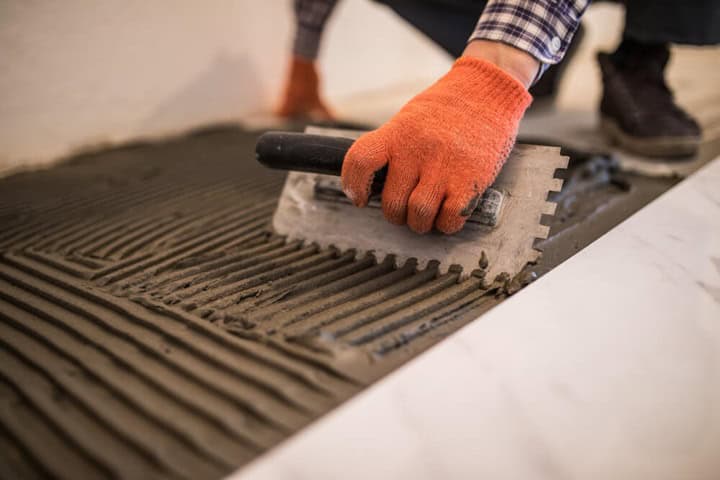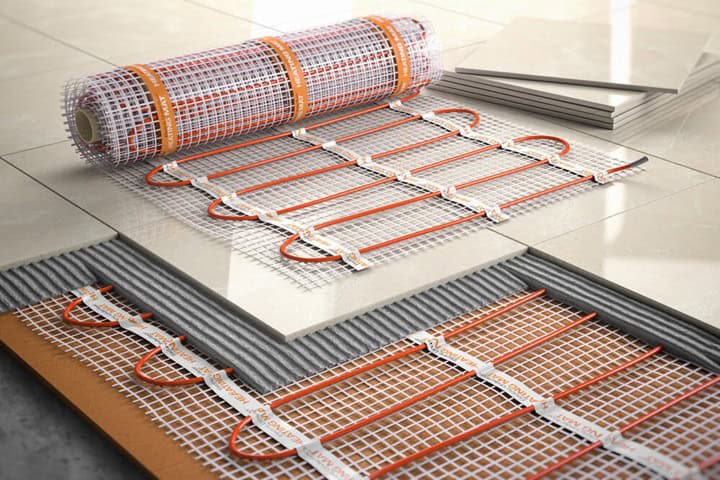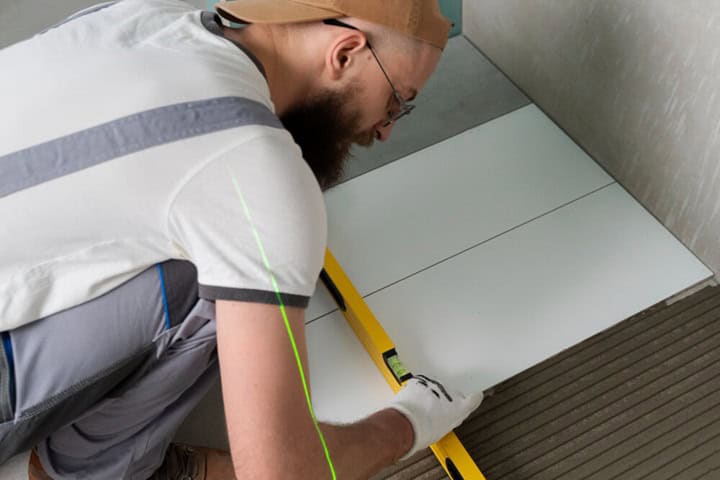Could the luxury of warm tiles by underfloor heating be risking the integrity of your flooring?
Many homeowners hesitate to install underfloor heating under tiles due to fears of potential cracking. But what exactly causes these issues? Can they be identified beforehand, and what checks can be done to ensure the risks don’t occur again? In this article, we will explore underfloor heating tiles problems, and uncover the reasons as to what can cause your tiles to become cracked by underfloor heating.
Key Points:
- Understand the relationship between underfloor heating and tile structure.
- Explore the common causes of tile cracking with underfloor heating systems.
- Learn how to properly install tiles over underfloor heating to prevent damage.
- Discover how to replace cracked tiles without compromising your heating system.
- Review tips for choosing the right tiles and underfloor heating to improve floor longevity.
- Underfloor Heating and Tile Compatibility
- Factors That Lead to Tiles Cracking
- 1. Thermal Expansion and Contraction
- 2. Incorrect Installation
- 3. Quality of Materials
- 4. Adhesive and Grout Issues
- 5. Accidental Impacts
- 6. Lateral Subfloor Movement
- Can You Replace Cracked Tiles on an Underfloor Heating System?
- Choosing the Right Underfloor Heating System to Prevent Tile Damage
- How To Install Tiles Over Wet Underfloor Heating
- How To Install Tiles Over Electric Underfloor Heating
- Keep Your Home Warm With Underfloor Heating
- FAQs
- Sources
Underfloor Heating and Tile Compatibility
Having underfloor heating positioned in colder rooms in the house, such as kitchens and bathrooms, will undeniably make them more comfortable and enjoyable to be in. However, homeowners often express concerns that underfloor heating might crack their beautiful tiles. The question, therefore, is: can underfloor heating crack tiles?
While underfloor heating and tiles can be a perfect match compared to other flooring types such as carpets, understanding what causes tiles to crack can still impact the compatibility of the flooring, as well as the suitability of your underfloor heating.
Factors That Lead to Tiles Cracking

Tile cracking usually isn’t caused by the heating system alone. Several factors can also contribute to this issue. The following factors are the most common likely suspects of your tiles cracking over underfloor heating:
1. Thermal Expansion and Contraction
Tiles, like all materials, expand and contract with temperature changes.
When underfloor heating systems are not correctly installed or switched on properly, this can lead to what’s known as thermal shock. This sudden change in temperature can stress the tiles, potentially leading to cracks.
2. Incorrect Installation
Under tile heating problems often stem from installation errors.
For instance, laying tiles directly on top of heating elements without appropriate insulation or screed layers can lead to uneven heating, creating stress points on the tiles.
3. Quality of Materials
Not all tiles are the same; there are many types of tiles that you should know about. The quality of the tiles play an important role in how well they will handle the stress of heat.
Porcelain, ceramic, and natural stone tiles are typically more durable and heat-resistant, making them ideal for underfloor heating.
4. Adhesive and Grout Issues
If adhesive and grout don’t fully cure before activating the heating, the screed may crack. This can weaken these materials, leading to tile movement and eventual cracking.
5. Accidental Impacts
Tiles can sustain damage in numerous ways, but accidental breakages are among the most common. A dropped kitchen item or a moving piece of furniture can easily crack a tile. The simple fix is to replace the damaged tile, but ensuring you have spare tiles on hand makes this process smoother and easier.
Additionally, heavy furniture or appliances can place significant pressure on tiles, leading to fractures. It’s strongly advised not to place heavy objects directly on tiles, especially in areas with underfloor heating, where the structure of the tile could be compromised by the heat underneath.
6. Lateral Subfloor Movement
Lateral subfloor movement is another significant factor that can impact your underfloor heating and cause tile issues. This occurs when the subfloor and floor finish expand and contract at different rates, often due to temperature changes or moisture. This dispersion of heat can lead to cracks if the tiles are not correctly fitted to the subfloor.
To combat this, installing a decoupling membrane between the subfloor and tiles is highly recommended. This membrane acts as a buffer, absorbing the differential movements and protecting the tiles from cracking.
Can You Replace Cracked Tiles on an Underfloor Heating System?
Replacing cracked tiles over an underfloor heating system should be handled with care to avoid damaging the heating elements or the screed. The process involves removing the adhesive and any damaged tiles gently, then applying new adhesive and tiles accordingly, ensuring everything is level. This should ideally be done by professionals, especially if the tiles are over a heating system, to ensure the integrity of both the tiles and the system itself.
If the cracking is due to thermal shock, it might require more extensive repairs like re-screeding.
Choosing the Right Underfloor Heating System to Prevent Tile Damage

For homeowners looking to install underfloor heating systems that are compatible with tile flooring, electric underfloor heating systems are the ideal option, since they are low maintenance and easy to install. Water underfloor heating systems also come available with low profile overlay underfloor heating options, making it even easier to integrate into your home without extensive renovations required.
How To Install Tiles Over Wet Underfloor Heating
When installing tiles over a wet underfloor heating system, ensure first that the underfloor heating adhesives are properly cured and ready to withstand the heat from the system without causing the screed or tiles to crack later on.
For sand/cement screeds, a minimum cure time of 21 days may be required before the heating can be switched on. In the case of calcium sulphate screeds, specific guidelines must be followed to ensure that they are compatible with your tiled flooring.
Before tiling, the underfloor heating system must be fully commissioned, involving a thorough heat up and cool down cycle over approximately seven days. This step will aid in identifying any potential weaknesses in the screed that could lead to future problems.
Unsure of switching off your underfloor heating? Learn how to turn off underfloor heating.
- Ensuring Proper Movement Joints
Placing joints in the right place will help to stop the tiles from cracking when the screed moves due to uneven temperature changes.
These joints should be strategically placed between different heating zones, at door thresholds, and around the right perimeters. Ignoring this step can lead to significant tile and floor failures, a common issue in underfloor heating tiles problems.
- Moisture Testing and Adhesive Selection
Testing for moisture levels in traditional cement-based and calcium sulphate screeds is also necessary, ensuring levels are at or below 75% RH with a hair hygrometer.
Choosing the best adhesive for underfloor heating can dramatically impact the heating results emitted from your heating system. Contact us today and see how we can help.
- Tiling for Heated Floors
During the tiling process, it’s important to maintain a moderate ‘cutback’ temperature, generally around 15˚C, to prevent the adhesive and grout drying too rapidly.
Planning the tile layout to allow room access without stepping on fresh tiles is also important, as is the use of the correct trowel and spacers to ensure an even bed for the tiles.
- Grouting and Curing
Grouting should follow precise mixing instructions to avoid inconsistencies and potential weaknesses in the grout lines. Once tiling and grouting are complete, maintaining a stable temperature for at least seven days is essential before gradually bringing the underfloor heating up to full operation.
This gradual increase helps prevent thermal shock, which can cause underfloor heating tiles problems.
How To Install Tiles Over Electric Underfloor Heating

For electric underfloor heating, which often involves radiant mat or cable systems, start by ensuring the subfloor is clear, sound, and stable.
Manufacturers typically provide specific guidance for embedding these systems in a cementitious self-levelling compound, which helps distribute the heat evenly and protect the integrity of the floor.
- Using Self-Levelling Compounds
The application of a self-levelling compound is recommended for covering heating cables. This compound should be applied so it covers the highest points of the cables by at least 3mm, providing a smooth, level surface for tiling.
Care must be taken during this process to avoid damaging the heating elements.
- Testing and Functionality Checks
Throughout the installation process, regular testing by a qualified electrician is mandatory to ensure the system is installed correctly and functioning as expected, as well as your own safety.
Even after installing your electric underfloor heating system, you should continue to have installation checks annually which will aid in flushing out any issues that you may experience.
Keep Your Home Warm With Underfloor Heating
In conclusion, while underfloor heating offers the comfort of warm tiles, it’s important that correct installation and maintenance methods are maintained before, during, and after the installation, otherwise this will not only impact your underfloor heating, but your tiles as well, leading to greater costs to fix and maintain.
By understanding and addressing these factors, homeowners can enjoy the luxury of underfloor heating on tiled floors without compromising the integrity of their tile flooring.
FAQs
Are certain types of tiles more likely to crack with underfloor heating?
Porcelain and ceramic tiles with underfloor heating are less likely to crack due to their low moisture content and high density. Natural stone tiles, while also suitable, may require specific installation techniques due to their natural variations and thermal properties.
Is there any special care or maintenance needed for tiles over underfloor heating to prevent cracking?
Regular maintenance for your underfloor heating with tiles to prevent cracking includes:
Keep the heating at a consistent temperature during cold months.
Avoid sharp temperature fluctuations.
Clean the tiles regularly to avoid any buildup of debris that could cause stress on the tiles.
Inspect the grout and sealant periodically and repair any damages to prevent moisture penetration.
Can you carpet over tiles with underfloor heating?
Yes, you can place carpet over tiles that have underfloor heating, but be mindful that adding layers like carpet can affect the heating efficiency. Each additional layer increases the floor’s thermal mass, which means it will take longer for the floor to warm up and cool down.
Sources
Cutmore, A., (2023) 12 different types of tile – and the pros and cons of each one. Homes & Gardens. [online] Available at: https://www.homesandgardens.com/bathrooms/types-of-tile [accessed 04/04/2025]
